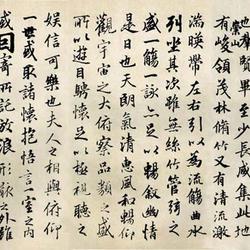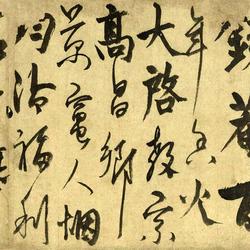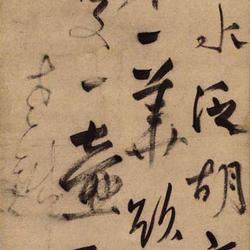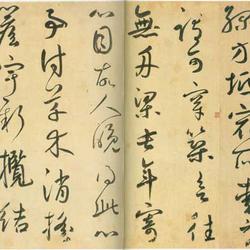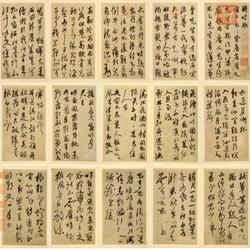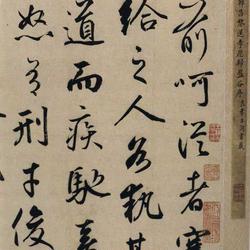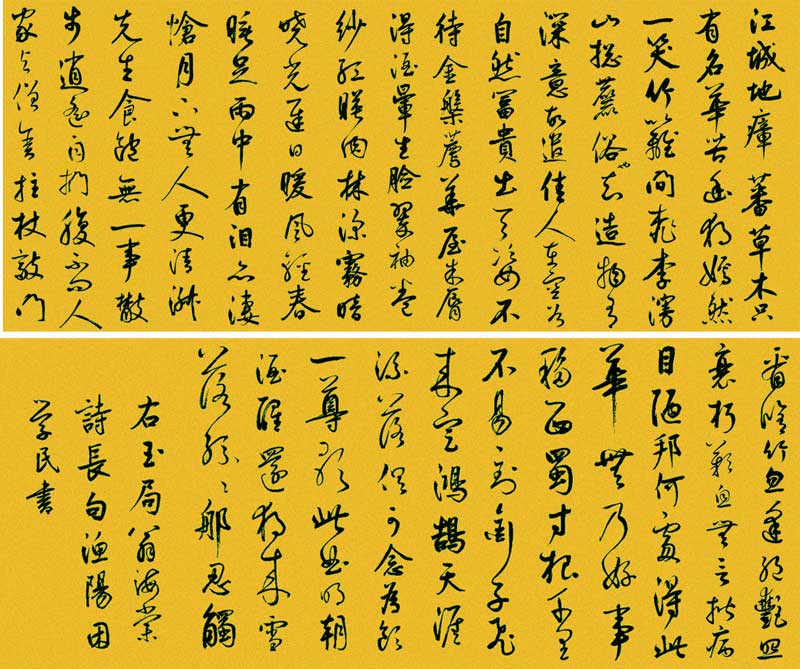
Xian Yushu's "Book of Poems of Su Shi and Haitang", paper 34.5X584cm, written in the fifth year of Dade in 1301, collected by the Palace Museum in Beijing
Right click to download and unzip (password 9610.com)
Appendix: Xian Yushu's "Book of Poems of Su Shi and Haitang"
Author: Unknown Source: "Chinese Calligraphy and Painting News"
Throughout the history of calligraphy, due to the "backlash" against the "Shangyi" calligraphy style of the Song Dynasty, the calligraphy circle of the Yuan Dynasty reappeared the trend of retro-respecting the law. Xian Yushu, like Zhao Mengfu, became the "return to the traditional classic calligraphy trend in the early Yuan Dynasty". Pioneer" (Huang Dun's words).
According to the "Epitaph of Xianyu Fujun", Xianyu's family has been a scholar for many generations. Xianyu Shu was inspired by his grandmother's ink when he was young, and later consulted Zhang Tianci, a calligrapher of the Jin Dynasty. Liu Zhi, a native of the Yuan Dynasty, described his calligraphy experience: "Xianyu Kunxue (Xianyushu's name is "Kengxue Mountain Min"), he first studied Aodun, Zhou Qingzhuxuan, and later Yaolu Gongxuezhai, experienced Hunan Xiansi, and met Li Beihai "Yuelu Temple Monument" is something I have learned. When I traveled to Jiangsu and Zhejiang with Zhao Gongzi, his book made great progress, and he became famous for it, and he was the first in cursive writing." While asking for help and communicating with Shi Yan, Xian Yushu It also approached the Tang and Song Dynasties, and traced back to the Wei and Jin Dynasties, "deliberately studying ancient books, the water in the pond is almost black" (Zhao Mengfu's poem). He has many kinds of famous calligraphy in his collection, especially Yan Zhenqing's "Manuscript of Sacrifice to My Nephew" which he treasures even more. He calls it "the second in the world in running script and the first in my family's Dharma script". Books such as "Shiqu Baoji" and "Daguan Lu" record that he copied Wang Xizhi's "Seventeen Tie", Wang Xianzhi's "Qun Ge Tie", Yan Zhenqing's "Deer Breast Tie" and Huai Su's "Autobiography Tie" and other ink writings. Many Dharma posts also have his wonderful inscriptions and postscripts, such as "The calligraphers have King Zhong, just like the Confucianists have Zhou Kong. Today's scholars talk about the 'two kings' without mentioning Zhong. They still call them Confucius and Mencius without saying anything." "The Duke of Zhou". According to Ming Fengfang's "Shu Jue", Xian Yu Shu's Xiaokai script was based on Zhong Yao's method. At the same time, he was also good at imitating nature. According to records, he "studied calligraphy at an early age and was ashamed to be inferior to the ancients. Occasionally, I saw two people pulling a cart in the mud in the wild, and then I realized the writing skills..." This is similar to Zhang Xu's sword dancing, Huang Tingjian saw the rowing and realized that the writing method has the same principle.
Xian Yushu had an outspoken character. Chen Yi, a contemporary calligrapher, once said: "In this generation, Xian Yushu is the only doctor (referring to Xian Yushu) who is good at hanging calligraphy on his wrist. When I asked him, he stretched out his arms with anger and said: 'Courage! Courage! Courage!'" This kind of arrogance The secular and bizarre personality is especially reflected in the line and grass creations - vigorous and unbridled, free and unrestrained. Zhao Mengfu highly praised this. He once said: "Yu and Boji (Xianyu Shuzi Boji) were classmates in cursive writing. Boji was far ahead of Yu. He tried his best to catch up but could not catch up..."
Among Xian Yushu's extant ink writings, "Su Shi Haitang's Poems Volume" can be regarded as one of his masterpieces. This line of papyrus is 34.5 centimeters long and 584 centimeters wide. It records Su Shi's seven-character poem "Haitang". The back of the scroll contains inscriptions and collection marks from many calligraphers since the Yuan and Ming dynasties. Gui's postscript of Yuan Qiu said: "Xianyu Weng's cursive calligraphy compiled the 'Six Meanings' (author's note: "Six Arts" refers to the "Yi", "Book", "Poetry", "Li", "Yue", "Spring and Autumn" and "Six Classics" ), not a single stroke has been left out. Everyone knows that he is powerful and powerful, but they don’t know that he has six meanings in it." Dong Qichang of the Ming Dynasty said: "Mr. Gai Dongpo wrote "Begonia Poetry" many times, no less than ten volumes, Boji wanted to I attached poems by famous sages to pass down their books, so I should give it my best effort."
This volume was written by Xian Yushu using a very elastic hard brush, mainly running script, and also using cursive script. His writing style mostly adopts the Tang style. As Yuan Chu from the Yuan Dynasty said: "He is good at turning back the wrist, so his writing is round and vigorous. It may be said that he mostly uses the Tang style." Ruan Yuan, a Qing Dynasty man, also said that Xian Yushu's "handwriting is lively and powerful, which is more vivid and powerful than Sun Guo's." Between Ting and Li Beihai (Yong)." A closer look at this volume shows that there are many similarities with Yan's "Manuscript of Memorials to Nephews", "Tie of Liu Zhong Envoy" and "Tie of Struggle for Seats". The writing style is wild and full of excitement. There are about 200 words in the whole article, "I will pay it with all my strength" and "I will not leave a single word behind". Judging from the strength of the brushwork, the sharp edge is concentrated and the ink is concentrated, and the round force is powerful. The rise and fall, pause, and twist of each stroke are all calm and unhurried, but yet ever-changing. For example, when you gather ink to form "dots", there are regular dots, side dots, overhang dots, continuous dots, etc. They may be large or small, light or heavy, and the structure is appropriate and seamless. All kinds of "elements" of horizontal, vertical, oblique and oblique character construction can be used to the best of their ability, such as "miasma", "jian", "hua" and "chang". Although there are many horizontal strokes, "yan" "Don't fly together" takes shape according to the situation; the vertical paintings in the characters "miasma", "grass", "hua", "halo" and "中" are mostly in the shape of "hanging needle", with strong and straight strokes... ...The structure is slightly upward-right, broad and grand, and vertically convergent; the middle part of the cursive script is weedy, regular and varied, adding to the lively and lively interest. The composition of this scroll is almost evenly spaced from top to bottom, evenly spaced, neither irritating nor harsh, and natural and smooth. The characters are related by "pulling threads", and the internal gestures of the strokes make the upper and lower parts respond freely, and the left and right sides give way to each other. Looking at the whole volume, as Mr. Liu Xingeng said: "The knots are rigorous and unbridled, the dots and lines are crisp and three-dimensional, and the movements are majestic and out of order. He demonstrated his pursuit of the formal beauty of calligraphy with his profound skills. and creativity, thus also expressing one’s own temperament and personality.”
Although his peers praised Xian Yushu as "every pen has ancient methods and is a treasure" (Zhao Mengfu said), he adhered to Tang methods and rejected Song people. Pan Zhicong's "Calligraphy Li Gou" of the Ming Dynasty criticized: "Yuan people since In addition to Zhao Wuxing (Meng Fu), Xianyu Boji's voice and price are almost the same as his. They are extremely round and healthy but can't get rid of the vulgarity." Ming Dynasty scholar Fang Xunzhi also pointed out that his "posture is full of majesty but lacks rhyme". The reason why the calligraphy world of the Yuan Dynasty, which mainly focused on "returning" to tradition, was relatively "lonely" in the history of calligraphy was because it had many inheritances and few innovations. Xian Yushu was not immune to "vulgarity", which was the main reason why his calligraphy was criticized by later generations.
Xian Yushu's calligraphy skills were "extremely profound, and few people knew about them at that time" (original words from Deng Wen, a native of the Yuan Dynasty). In his later years, he closed his doors to thank guests, paid no attention to worldly affairs, and took great pleasure in tuning the piano and composing calligraphy. In 1989, the tomb of Xian Yushu was discovered in Hangzhou. The funerary objects included seals, inkstones, pen end ornaments and other things that Xian Yu played with during his lifetime.
Explanation:
Jiangcheng is surrounded by miasma and vegetation, and only famous flowers are bitter and lonely.
Between the beautiful smile and the bamboo fence, the mountains of peaches and plums are always vulgar.
I also know that creation has deep meaning, so I send a beautiful woman to the empty valley.
Wealth and honor naturally come from heaven, and there is no need to wait for a golden plate to recommend a gorgeous house.
The red lips are dizzy with wine and the face is red, the green sleeves are rolled with gauze and the red flesh is reflected.
The forest is deep and foggy, the dawn is late, the sun is warm, the wind is gentle, and I have enough sleep in spring.
There are tears in the rain and sadness, and no one is more beautiful under the moon.
The husband has nothing to do when he is full, and he takes a leisurely walk to check his belly.
Ignoring other people's houses and monks' houses, I knock on the door with my stick and look at the bamboos.
Suddenly, when the beautiful light fades away, I sigh, speechless and wipe my sick eyes.
Where can I get this flower in a poor country? It is a good thing to move it to Western Shu.
It's hard to reach even an inch of root thousands of miles away, but the swans fly to catch the swans.
Anyone who wanders around the world can think of it, and sing this song just to drink.
Tomorrow I will wake up and come alone, and the snow will fall one after another.
There is a long poem by Weng Haitang in Youyu Bureau.

